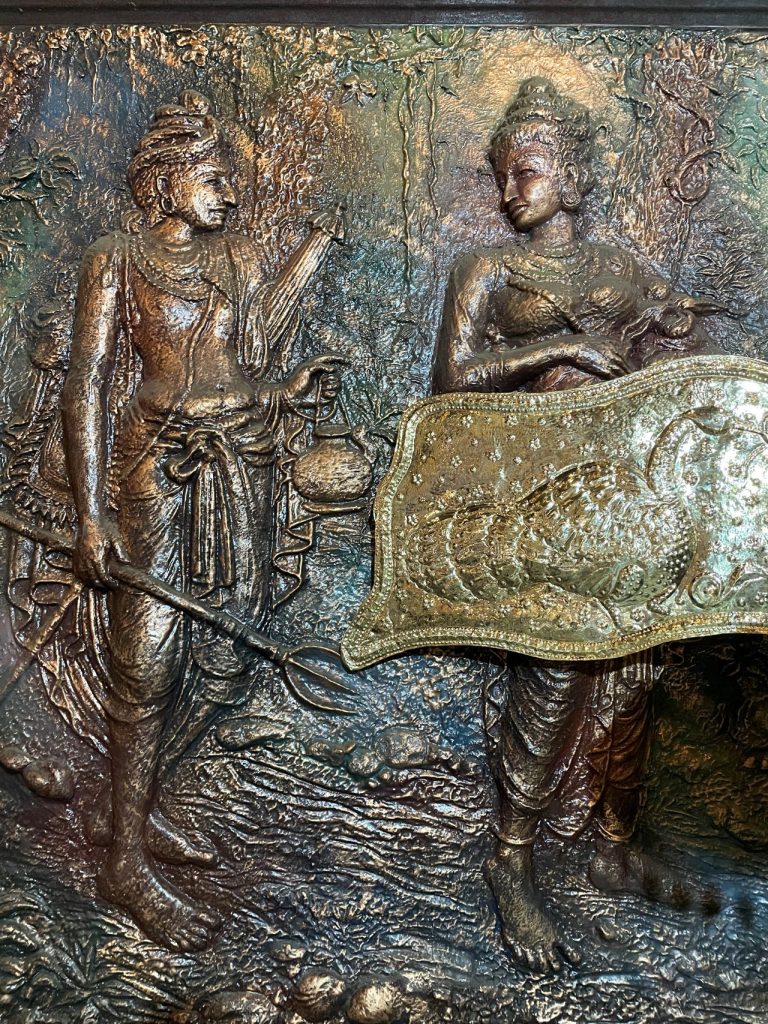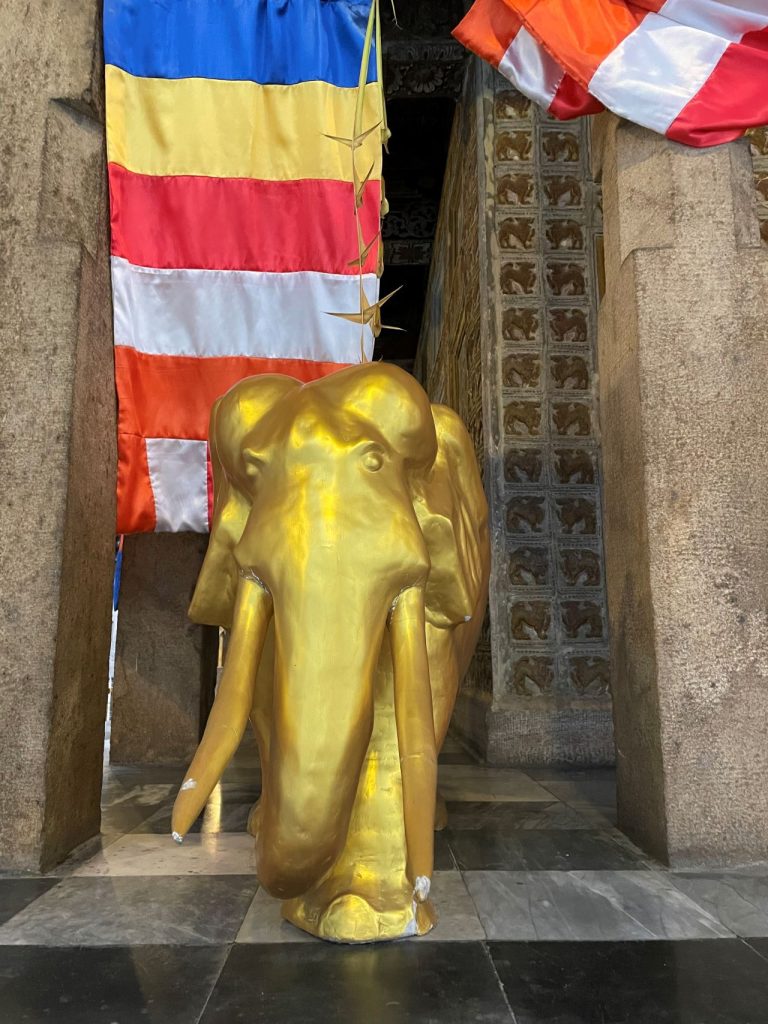SHRI DALADA MALIGAWA- TEMPLE OF THE TOOTH RELIC IN KANDY
SHRI DALADA MALIGAWA- TEMPLE OF THE TOOTH RELIC IN KANDY
SHRI DALADA MALIGAWA- TEMPLE OF THE TOOTH RELIC IN KANDY
My fascination for the Kandy Tooth Relic Temple or the Kandy Dalada Maligawa shrine started with the one painting that I saw in a palatial temple called Kelaniya Raja Maha Vihara, located about 11 kms from the Srilankan capital, Colombo. Kelaniya Temple is a magnificent Buddhist temple filled with large murals and sculptures and it is of spiritual significance to both Hindus and Buddhists. However, the temple was once a palace and it also marked the culmination of Lord Rama’s tryst with Lanka. It was believed to be a palace handed over to Vibeeshana, Ravana’s brother after the war.

However, the local Buddhists believe that Buddha preached to his disciples when he visited the island after gaining enlightenment. There is a gem-studded throne enshrined in the temple and it is believed that Buddha sat on the throne when he gave his Dharma sermons. The temple which was later controlled by the colonial powers was rebuilt about a century ago.
SHRI DALADA MALIGAWA- TEMPLE OF THE TOOTH RELIC IN KANDY
My fascination for the Kandy Tooth Relic Temple or the Kandy Dalada Maligawa shrine started with the one painting that I saw in a palatial temple called Kelaniya Raja Maha Vihara, located about 11 kms from the Srilankan capital, Colombo. Kelaniya Temple is a magnificent Buddhist temple filled with large murals and sculptures and it is of spiritual significance to both Hindus and Buddhists. However, the temple was once a palace and it also marked the culmination of Lord Rama’s tryst with Lanka. It was believed to be a palace handed over to Vibeeshana, Ravana’s brother after the war.

However, the local Buddhists believe that Buddha preached to his disciples when he visited the island after gaining enlightenment. There is a gem-studded throne enshrined in the temple and it is believed that Buddha sat on the throne when he gave his Dharma sermons. The temple which was later controlled by the colonial powers was rebuilt about a century ago.

The sculptures and murals here celebrate Buddha’s life and it was believed to be painted by local artist, Solias Mendis. While there are several paintings, a few of them were iconic. One of them depicted the arrival of Samrat Ashoka’s daughter Sangamitra landing on the island with a sapling of the Bodhi tree. Another painting showcased the journey of Buddha’s sacred tooth relic from India to Srilanka.

Princess Hemmamali was apparently the daughter of King Guhasiva of Kalinga and Prince Danta was the son of King Udeni who came to Kalinga to worship the sacred relic which was guarded by the Kalinga rulers. They later get married and the Princess hides the tooth relic in her hair as she entered Srilanka. They later handed it over to the king Sirimeghavanna of Anuradhapura who enshrined the relic in his capital, before the relic eventually found a sacred home at Kandy. It was an inexplicable feeling, being at the Kandy Tooth Relic Temple or the Kandy Dalada Maligawa as its called, and later as we watched the colourful and dramatic pageant of the Kandy Esala Perahera, we were virtually overwhelmed.

We landed in Kandy town just as the festivities were beginning and the city was all dressed up in vivid shades. We were staying at the Mahaweli Reach hotel, by the banks of the Mahaweli River and the entire town had a vibrant vibe as well. Kandy is synonymous with the Temple of the Tooth Relic, also referred to as the Shri Dalada Maligawa and it is a UNESCO World Heritage Site and one of the best places to visit in Kandy. The temple is a part of the royal complex as the kings were the guardians of the sacred relic, which is the left canine tooth of Buddha.


Historically, Kandy, earlier known as Senkadagala or Senkadagalapura and was founded in the mid-14th century and lasted for 450 years until the 19th century. The kingdom of Kandy as it was referred to was ruled by different kings and dynasties until it eventually became a part of the various colonial powers – Portuguese, Dutch, and eventually the British. The town, which was once referred to as Maha Nuwara or the Capital, referring to it being the last capital city of the monarchy and hence the royal complex with the temple is one of the best places to visit in Kandy.

While the Portuguese referred to it as Candea, the name Kandy was an Anglicised version of the original word, Kanda Uda Rata, or the land on the mountain. While the Sinhala rulers safeguarded the relic while ruling from Kandy, the town was briefly under the control of the Nayakkars from Madurai in South India. It is believed that the Kandy Tooth Relic temple was rebuilt around four times and further restored and reconstructed even after the civil wars.


Today, the guardians of the sacred relic housed inside the Kandy Dalada Maligawa are the monks who are also custodians of the cultural and religious rituals.

It was a mystical feeling being at the Kandy Tooth Relic Temple in the wee hours of the morning, for the dawn ritual. The divine energy was everywhere. The music echoed from the shrine. The sky was dark but the entire atmosphere was lit adding to the dramatic setting.

The temple itself was built initially as a two-storeyed structure in the 16th century, only to be destroyed by the Portuguese and the Dutch. The relic was however safely transported to another shrine and was brought back here again after the temple was reconstructed in the 18th century.

The temple was adorned with intricate carvings using gold, silver, bronze, and ivory among other precious stones. Paintings and murals greeted us everywhere. The first thing that I saw was the parapet of white with beautiful brick walls reflecting in the waters of the moat, referred to as the Cloud Wall or the Wall of Water Waves.


Lamps were once lit on the tiny windows or holes carved on the wall. However now lights adorned the temple adding a touch of glitter to the dawn. The octagonal pavilion called the Paththirippuwa was once used by royalty to address the people.

As dawn broke, I could see devotees dressed in white making a quiet beeline with floral offerings toward the entrance of the Kandy Dalada Maligawa. Two carved elephant sculptures guarded the main gate which stood above the moat called Mahawahalkada and below the same is the Sandakada pahana or the moonstone.


We entered through the Hewisi or the drummer’s chamber where percussionists and musicians performed while we moved from the lower floor called Palle Malaya to the upper floor, Udu Malaya to pray to the Tooth Relic, which is kept in seven golden caskets studded with gemstones, inside a chamber referred to as Handum kunama. While the caskets represent a stupa, there is a separate casket for the Kandy Esala Perahera, when the tooth relic is taken out with reverence during the procession.



As the music faded in and out, we stood in a silent queue with offerings of flowers and fruits as we got a glimpse of the Tooth Relic. It was a hallowed moment. I could feel the energy flowing through my body and mind. It was sheer bliss to spend a few moments here, but it felt like an eternity. The early morning ritual lasts for just a few minutes and the doors open only twice later in the day, during noon and in the evening.

I spent more time exploring the Kandy Tooth Relic temple. Surrounded by the Kandy Lake and the forests and mountains, which are some of the best places to visit in Kandy for the tourists, the shrine is a part of the royal complex with several monuments and temples, some dedicated to the Hindu deities as well like Vishnu, Skanda, and Muthumariamman, The latter are referred to as Kataragama and Patini here in Srilanka.



Elephants posed for us in the courtyard of the Kandy Dalada Maligawa as we visited some of the Hindu shrines in the temple complex. While the Nath Temple and the Patini Devi Temple were within the complex, the Vishnu temple was a few steps away, while the Katragama or the Skanda temple was built in the town.


While the elephants were brought here from various temples and orphanages for the Perahera, it was fascinating to find them in striking poses as they grazed inside the premises. Elephants are revered in Srilanka as well

The Kandy Tooth Relic temple itself is built in the Kandyan style of architecture with pillars and arches, pavilions and halls. While the base of the temple is built with granite, a variety of stones – from marble, limestone, ivory and even wood have been used to build the ensemble of monuments around the temple complex. Paintings, carvings and wooden pillars and arches adorn the temple.

There is also an archaeological museum in the complex along with the palaces of the king and queen. There is an audience hall as well with wooden pillars and carvings.

As we walked around both inside and outside the temple complex, there were several Buddha shrines with stories etched on the walls. The silence was so soothing as we imbibed the spiritual energy.

Standing there in my white ensemble on the lush lawns and taking in the ethereal view of the temple, I realized the true essence of the living cultural heritage of the Sacred Kandy Tooth Relic Temple.

Later in the evening, when we saw the larger-than-life pageant of the Kandy Esala Perahera, I understood why the sacred tooth relic is worshipped as a form of Living Buddha himself.













Comments
Post a Comment